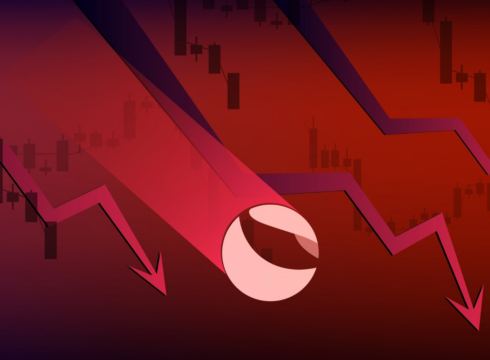SUMMARY
TerraUSD (UST) and Luna are two stablecoins issued by Terra, a public blockchain platform that makes it easier for businesses to create apps for people to trade
The effects of the stablecoin's 80% drop in currency value, which wiped out investors worth up to $45 Bn, are being felt by more established tokens such as Ethereum and Bitcoin
While we wait for the global economies to come together and better regulate the crypto space to inspire investor sentiment, Indian investors must proceed with caution
Inc42 Daily Brief
Stay Ahead With Daily News & Analysis on India’s Tech & Startup Economy
The recent failure of TerraUSD (UST) and its sister currency Luna has jolted the Indian and global cryptocurrency markets. The effects of the stablecoin’s 80% drop in currency value, which wiped out investors worth up to $45 Bn, are being felt by more established tokens such as Ethereum and Bitcoin. The depreciation of Terra and Luna has reignited speculation in the cryptocurrency market about their advantages and disadvantages. Even bullish crypto investors are taking precautions to protect their financial interests.
Here’s a look at the state of crypto investments in India following the Terra and Luna crashes.
Why Did This Stablecoin Fall?
UST and Luna are two stablecoins issued by Terra, a public blockchain platform that makes it easier for businesses to create apps for people to trade. Furthermore, the general public can invest in these stablecoins, with UST pegged at USD 1. To ensure stability, Terra would buy and sell these two coins in different markets.
Thus, the plan was to use this arbitrage to keep the price of UST stable at $1 while profiting from Luna. This would relieve the platform of the need to keep reservoirs of US dollars. The platform would track the market forces of demand and supply of both coins using in-built algorithms to keep them balanced. Furthermore, investors were enticed to buy USD and store it at Anchor, a piece of software that promised to grow their money like magical trees. It’s concerning that other crypto projects began promising exorbitant returns and are now in danger of collapsing. Investors should be aware that these algorithms are similar to “black boxes,” with the potential to fail spectacularly.
The same thing happened with UST and Luna. The system broke down in May, when large investors sold these stocks, causing a massive price drop. To counteract the falling prices, Terra announced planned to purchase Bitcoin, but this was insufficient to save the company. However, as of today, the true perpetrator of the UST and Luna’s demise is unknown.
What Does The UST & Luna Fall Mean For Indian Crypto Investments?
Indian markets have not been immune to the meteoric fall of Luna and Terra. Several Indian trading platforms quickly removed UST and Luna from their platforms. Furthermore, according to CoinMarketCap data, some of the popular coins or tokens traded in India, such as Bitcoin, Ethereum, Cardano, Binance, and others, have seen 30-60% drops in value. As a result, investor confidence has been shaken and must be restored.
While the global crypto market is valued at USD 1.2 Tn, according to CoinMarketCap, there are no official estimates in India. An Inc42 analysis found that more than 350 blockchain startups were operational in the country in 2021 with the cryptocurrency segment receiving the highest funding last year.
Aside from the UST and Luna crashes, the Indian crypto market has been harmed by a confluence of factors. This includes the aftermath of the war between Russia and Ukraine, as well as the government’s strict controls.
TDS on crypto transactions and a 30% capital gains tax on digital assets, including coins, are already sending investors into a frenzy. Investors may prefer unregulated or decentralised platforms such as P2P or foreign exchanges, limiting revenue gains for the government while posing new threats to Indian exchanges.
With the crypto market in India in disarray, investors must adhere to the fundamentals of investing:
- Diversify the portfolio
- Have risk mitigation and management framework in place
- Have a sound short-term and long-term strategy for investments
- Buy value, not hype!
- Invest in financial instruments, systems and currencies that you understand
Need For Better Regulations!
The collapse of UST and Luna has not only wiped out over $830 Bn from the global crypto space, but the plunge has been compared to the 2008 global financial crisis. It also jeopardises the ability of other crypto start-ups to raise funds. As a result, the beleaguered space requires improved regulation and governance.
Current taxation laws should be revised to make the sector more appealing to investors. Last year, the Narendra Modi government planned to introduce the Cryptocurrency & Regulation of Official Digital Currency Bill in the Lok Sabha during the winter session, which proposed to ban all crypto with the exception of a few private coins to promote the underlying technologies.
Furthermore, the Reserve Bank of India was to create its own official digital currency. Although the bill was not debated in the winter session, Prime Minister Narendra Modi did call for a globally coordinated action to regulate crypto assets in January. Given the technology involved, the Prime Minister stated in his address to the World Economic Forum that steps taken by a country in isolation will not be sufficient to regulate cryptos.
While we wait for the global economies to come together and better regulate the crypto space to inspire investor sentiment, Indian investors must proceed with caution. It is best to diversify one’s investment portfolio, look for alternative investment funds or other instruments, and work one’s way to financial independence.
Note: We at Inc42 take our ethics very seriously. More information about it can be found here.


